Boeing F/A-18E/F Super Hornet

The F/A-18E/F is an evolved F/A-18 meant to operate off of an aircraft carrier and perform a variety of fighter roles. It can be equipped for almost any type of mission from electronic warfare to air-to-air interdiction and bombing missions. The Super Hornet was ordered in 1992 by the United States Navy to replace a large, multi-faceted fleet of carrier aircraft. Fast, agile, and nimble, this twin engine jet fighter predominantly serves as a fighter escort and fleet air defense for a naval carrier group.
Combat Service
Its first combat deployment was in the Persian Gulf prior to the invasion of Iraq in 2002, where it enforced the “no-fly” zone. Cheaper to maintain than the F-14 Tomcat, it quickly became the tip of the spear for both the U.S. Navy and the Marine Corps. The major difference between the F/A-18E/F Super Hornet and the traditional F/A-18 Hornets is its ability to quickly assume almost any role the Navy requires and respond against advanced air and surface threats.

Boeing produces the Navy’s premier attack aircraft employed in attack, forward air control, tactical air control, and reconnaissance squadrons. Its predecessor, the F/A-18B, is still used for training purposes and the F/A-18D is still used as a primary attack aircraft, but the Super Hornet has been hailed as the perfect bridge between fourth generation jet fighters and advanced stealth multirole fighters like the F-35C Lightning II. Until the Navy receives its order of F-35Cs, the F/A-18E/F will continue to serve in that role.
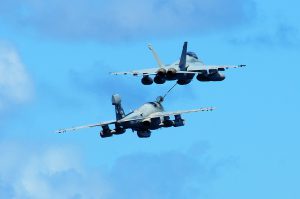
Backbone Of Naval Aviation
Another big difference between the F/A-18E/F and its predecessors is it is heavier, longer, and larger. Because of this, naval carriers have to adjust their arresting and catapult systems to account for the difference. Unlike previous hornets, the Super Hornet can also pack optional equipment to do tactical in-flight refueling to other Super Hornets. This allows these fighters to pass fuel between themselves and maintain a much longer duration in the air. Mission times with the slightly larger Super Hornet have been increased due to extended internal fuel capacity.
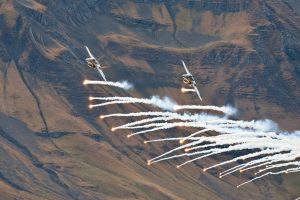
4.5 Generation Fighter
While the Super Hornet is a bridge-gap measure while the Navy waits for its order of F-35Cs, it is by no means a stealth aircraft. It employs unique design features to reduce radar cross section but relies upon advanced electronic warfare modules and counter-measures to survive in combat.
While procurement of the F-35 Lightning II is underway, the Super Hornets continue to be upgraded to enable them to face contemporary threats in the airspace. With over 1.1 million flight hours, the Navy has determined that each Super Hornet lasts roughly 6,000 flight hours before hitting its upper life limit.
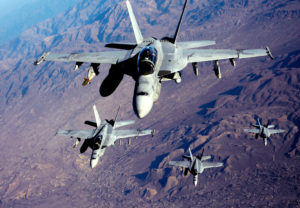
Latest Variants
F/A-18Es differ only slightly from F/A-18Fs in that the F variant is a two-seater and the E is a single seat jet. Both are employed extensively to conduct deep bombing runs within contested territory. While the Super Hornet program was offered to the Marine Corps, the Marine Corps opted to buy the Navy’s old F/A-18Cs in order to ensure they received their order of F-35Bs. At present, the Marine Corps deploys its F/A-18Cs in support of naval carrier groups which have since adopted the Super Hornets. In order to distinguish between traditional F/A-18s and the Super Hornets, the Super Hornets have been unofficially dubbed ‘Rhinos’ to avoid confusion.
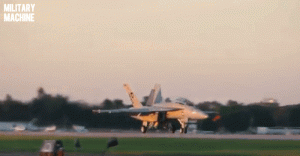 Electronic Warfare
Electronic Warfare
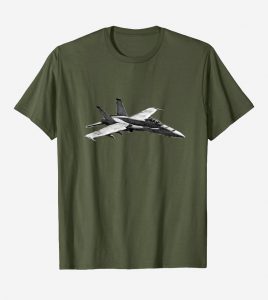
A special Super Hornet was engineered in order to fulfill the Navy’s need for an Electronic Attack-capable aircraft to replace its aging fleet of EA-6B Prowlers. The EA-18G is equipped with advanced electronic warfare jamming modules which enable it to aggressively attack enemy communications and electronics. It is employed both in support of naval operations and ground forces operating in theater.
Powerplant
The Super Hornet is powered by two General Electric F414-GE-400 turbofans. Each F414-GE-400 engines is capable of generating 13,000 pounds of force in dry thrust, 22,000 pounds of force with afterburners.
See F/A-18E/F Super Hornet Specifications
| Length: 60.3 feet (18.5 m) |
| Height: 16 feet (4.87 m) |
| Wingspan: 44.9 feet (13.68 m) |
| Maximum Take Off Weight: 66,000 lbs. (29,932 kg) |
| Airspeed: Mach 1.8+ |
| Ceiling: 50,000+ feet |
| Range: Combat: 1,275 nmi (2,346 km) |
| Ferry: 1,660 nmi (3,054 km) |
| Crew: E models: 1; F models: 2 |
| Unit Cost: $57 million |

